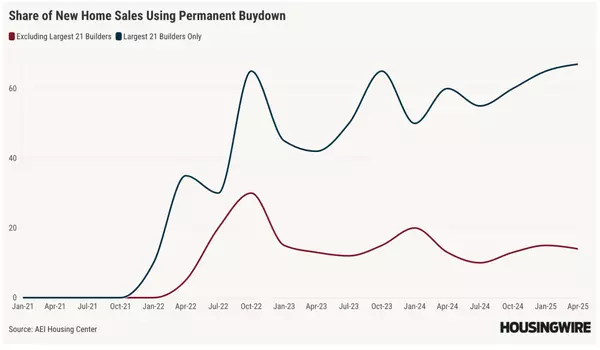Tech Pulse: Agent AI adoption remains slow; title fraud thwarted in Ohio

Welcome back to Tech Pulse — HousingWire‘s weekly series rounding up the latest in technology news, including tools, integrations and trends that impact mortgage and real estate. Here’s what happened this week: Real estate agent optimism holds steady, but AI adoption slow Kaplan’s inaugural Real Est
Read MoreGeorgia metros show sharp divide in days on market

Georgia’s housing market presents stark contrasts. The state reports a median 70 days on market for single-family homes. HW Data highlights a sharp divide, with some Georgia metros selling in weeks while others take months to turn. Quick-selling metros Hinesville-Fort Stewart leads the state’s large
Read MoreInventory-heavy states show wide gaps in sales speed

In the national housing market, states with the most active listings show wide differences in how quickly homes sell. HW Data shows California moving inventory the fastest, while Florida and Texas take longer despite carrying larger supply. California sets the pace California carries 57,065 active l
Read MoreCourt dismisses N.J. mayors’ challenge to affordable housing law

A New Jersey Superior Court judge has dismissed lawsuits from a coalition of state municipalities seeking to overturn a new affordable housing law — dealing a major setback to opponents of the policy. Assignment Judge Robert Lougy on Tuesday rejected two suits filed by the Local Leaders for Responsi
Read MoreNew tariffs on wood, furniture raise fears of higher housing costs

President Donald Trump’s decision to impose steep new tariffs on imported wood, furniture and home fixtures is drawing criticism from economists, builders and housing experts who warn the move could further strain an already fragile housing market. New tariffs in these sectors were first announced S
Read MorePlanet Financial Group boosts non-agency team with Rob Parsley and Tim Fisher hires

Planet Financial Group, the parent company of Planet Home Lending, announced two new hires this week. Rob Parsley was named senior vice president, non-agency sales and Tim Fisher was named senior vice president, non-agency lending. With a career spanning more than three decades, Parsley most recentl
Read MoreTop-producing Colorado teams combine forces

NextHome Front Range has joined West + Main Homes and rebranded as the Front Range Collective team, the companies announced. The move expands West + Main Homes’ footprint in Colorado across Fort Collins and Colorado Springs — providing the team’s 28 agents with additional resources and offices in th
Read MoreWhat we know about the labor market, even without Jobs Friday data
Jobs week ended with an eerie silence, as the government remains shut down and we didn’t receive the last two major reports for the week. Given that job growth has been slowing dramatically this year, it’s time to examine what is really going on. For me, the situation is straightforward: over the p
Read MoreNEXA Mortgage rebrands to NEXA Lending, but it’s not a pivot to retail

Mike Kortas wanted to be clear as he announced the company’s rebrand from the stage at NEXA Fest 2025: the company is not going into retail. The name change — from NEXA Mortgage to NEXA Lending — could seem like the prelude to lending in a new channel, but Kortas said it was actually a sign that NEX
Read MoreAlabama’s housing market reveals a growing affordability divide

Alabama’s housing market is splitting. Lower-priced homes are selling briskly, while higher-end listings linger, according to the latest HW Data. Affordable homes fuel pending sales Alabama’s entry-level homes are moving quickly. The state recorded 1,843 pending sales in its most affordable tier las
Read MoreFICO’s new program draws mixed reviews from mortgage market

Fair Isaac Corp.’s (FICO) decision to let resellers calculate and distribute its scores directly to lenders drew a mixed response from the mortgage industry — viewed by some as a step toward more competition, but by others as a potential driver of higher credit score costs in the short term. On Wedn
Read MoreReal estate agent optimism holds steady, but AI adoption slow
Kaplan Real Estate Education has released its first Real Estate Survey of Trends — highlighting both optimism about client growth and concerns over technology adoption in the industry. Nearly half of survey respondents (48%) expect to grow their client base in the next six to 12 months, with another
Read MoreWest Capital Lending partners with Mortgage Connections

West Capital Lending said on Thursday that it has entered into a strategic partnership with Mortgage Connections, a Michigan-based mortgage brokerage. Mortgage Connections, founded by Ali Younes & Joe Dakroub Esq., has closed more than 843 transactions and $239 million in funded loan volume over the
Read MoreCompass’ acquisition strategy faces new tests after Anywhere deal
When Compass began acquiring brokerages across the country a decade ago, the goal was clear; rapid expansion in key markets. It was the second phase of Compass’s plan to expand after offering agent sign-on bonuses and incentives that brought them quick growth. The company — now the largest residenti
Read MoreFrom rates to reality: why innovative homeownership alternatives matter now

For generations, the American Dream was synonymous with homeownership — a white picket fence, a backyard and the pride of owning a place to call your own. But today, that dream is undergoing a quiet transformation. With the national median home price now exceeding $426,000, according to NAR, the goa
Read MoreHomeSmart names Stacey Onnen president

HomeSmart has announced its appointment of Stacey Onnen as president. Onnen has more than 20 years of experience in real estate — most recently working in the legal technology sector and previously leading a national initiative at Keller Williams. She also served as president of operations at eXp Re
Read MoreGovernment shutdown halts new reverse mortgage endorsements

The Federal Housing Administration (FHA) said Wednesday it will continue processing claims during the government shutdown but cannot endorse new Home Equity Conversion Mortgages (HECMs) until funding is restored. That information was confirmed by the National Reverse Mortgage Lenders Association (NR
Read MoreThe Steven Cohen Team returns to Corcoran Group

After five years at Douglas Elliman, Steven Cohen and his team are returning to Corcoran Group, according to an announcement on Wednesday. The team will be affiliated with Corcoran’s East Side New York City office and it consists of nine real estate professionals: Scarlett Nawrocki, Stefanie Ruch,
Read MoreCalifornia MBA names Paul Gigliotti new CEO as Susan Milazzo retires

The California Mortgage Bankers Association (California MBA) announced a leadership transition on Wednesday, noting the retirement of longtime CEO Susan Milazzo and the appointment of Paul Gigliotti as her successor. Milazzo, who has served the association for two decades, will stay on as a consulta
Read MoreFICO bypasses credit bureaus with new program for mortgage lenders

Fair Isaac Corp. (FICO) has launched a program allowing tri-merge resellers to calculate and distribute its scores directly to mortgage companies, effectively bypassing the three nationwide credit bureaus: Equifax, TransUnion and Experian. The move comes amid intensified competition with VantageScor
Read More
Categories
Recent Posts










